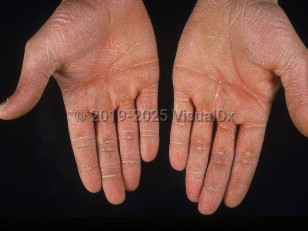Palmoplantar keratoderma in All Ages
Synopsis

Thickening of the palms and/or soles that cannot be attributed to friction alone. Multiple genetic forms exist. Cases are either inherited or acquired. Heritable PPKs are identified by the presence of a family history and childhood onset; they may manifest in isolation, as the defining feature of a syndrome, or as a minor aspect of a syndrome. Acquired PPKs occur later in life and have no associated family history. Look for thickening of the palms and/or soles with variable areas affected. Sometimes, there is plate-like scale or confluent, brown-to-yellow thickening. Patterns include diffuse, focal, and punctate. In the focal variants, the areas of hyperkeratosis can be very well defined.
Codes
ICD10CM:
Q82.8 – Other specified congenital malformations of skin
SNOMEDCT:
706885006 – Palmoplantar keratoderma
Q82.8 – Other specified congenital malformations of skin
SNOMEDCT:
706885006 – Palmoplantar keratoderma
References
Subscription Required
Last Updated:12/27/2015
Palmoplantar keratoderma in All Ages

